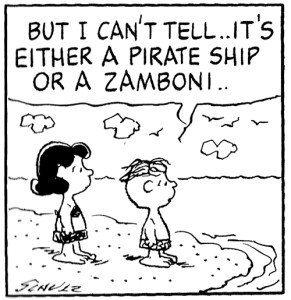A Year of Reading Peanuts, Part 1: 1995 – 1998
As I mentioned about a month ago, my goal for 2016 is to read all of Charles Schulz’s classic comic strip Peanuts, from its beginning in 1950 to its end in 2000. My plan, starting today, is to update you every week on how this is going. Accountability is important when one is embarking on a project like this.
The inspiration to read Peanuts came when my sister gave me the boxed set of The Complete Peanuts 1995-1998 for Christmas. And, even though these are volumes 22 and 23 in a 24 part series, I started reading there, so that’s what my first blog post is about.
The accepted wisdom tells us that Peanuts peaked in the 60s, and that by the end, in the 90s, the strip was a shadow of its former self. So, first off, it was way better than I expected, because my expectations were fairly low. It’s probably dangerous to think in terms of “eras” when looking at a long-running work like this, because you’re inclined to dismiss entire decades. In these two volumes, there may be more mediocre strips and fewer great strips than in earlier collections, but there’s still great strips mixed in.
Some things you might not know about the near-last days of Peanuts:
*Charles Schulz was obsessed with Zambonis (see above). There are so, so many comics where the punchline involves the word “Zamboni.” I’m serious. In fact, these Fantagraphics Peanuts collections are really well indexed, so I can give you an exact number. In the 1995 to 1996 volume, the word “Zamboni” shows up on seven different pages. In 1997 to 1998, that number drops to six, but still. Many cartoonists go an entire career without using the word once. I know that Charles Schulz started every morning getting a cup of coffee at the ice rink he built. Apparently the ice rink gave him lots of inspiration.
*Rerun is one of the major characters. Do you know Rerun? He’s Lucy and Linus’s little brother. I believe he was born in the early 80s. In the last years of the strips, he starts Kindergarten. There are a number of strips where he hides under the bed rather than go to school.
*Other running gags you may not be aware of: Snoopy as one of George Washington’s soldiers at Valley Forge, Linus hearing the coyotes howling at night, Sally looking for a personal philosophy, Rerun wanting to play with Snoopy, and Rerun wanting a dog.
*There was a reference to the internet, which kind of blew my mind. On the whole, Schulz seems to be living in an earlier era—Charlie Brown and Rerun play marbles, for instance, which I don’t remember any little kids actually doing in the 90s.
*Pigpen actually shows up in these strips. I was excited. I didn’t expect to see him.
*Since 1999 was the last full year of Peanuts, as I was reading 1998, I kept thinking, this could be the last time we ever see this character–like Franklin. Franklin showed up, and I wondered, is this the last appearance of Franklin? It could be. I was pleasantly surprised when Patty (not Peppermint Patty, just plain Patty) and Violet showed up. I didn’t know if they even appeared at all in the last decade of the strip. They don’t have any lines, but when Schulz needs a crowd of kids, he drops them in.
*In this late stage, the main characters are Charlie Brown, Snoopy, Sally, Lucy, Linus, Rerun, Shroeder, Peppermint Patty, and Marcie. And Woodstock, I guess, if you count birds as characters. I’m biased, I prefer the strips with humans to the dog-and-bird ones
*Snoopy’s brothers Spike, Olav, and Andy show up quite a bit. Especially Spike. Unfortunately, I almost never find the Spike comics funny. In particular, Schulz has a running joke that Spike is friends with Mickey Mouse, and Mickey Mouse gave Spike a pair of shoes. This comes up over and over and over and it’s never funny to me. I just don’t get it.
*Schulz does seem to keep it consistent that Peppermint Patty, Marcie, and Franklin go to a different school than Charlie Brown, Lucy, and Linus, but it always bothers me when Charlie Brown is in the same class as Linus. I mean, Charlie Brown has to be at least five years older than Linus . . . but no, that way lies madness. Time does not work the same way in Peanuts as it does in our world.
On the whole, these strips work because the characters are so rich and thoroughly developed that it’s fun to spend time with them, even when a specific joke doesn’t quite land.
That said, how did it all begin? I’ll let you know next time, when I head back to 1950 and begin reading Peanuts from the beginning.

Comments are closed.